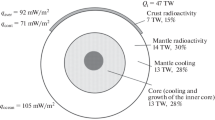Abstract
Heat transport in the Sun is describable by a Fokker-Planck, or diffusion, transfer equation. A study of the general character of the solutions of the transfer equation shows that the inhibition of convective transport beneath the photosphere produces a photospheric dark ring surrounded by a bright ring, or at best, a dark area surrounded by a bright ring. The mean temperature beneath the ‘sunspot’ is unavoidably above normal, so that the enhanced gas pressure would disperse, rather than concentrate, the magnetic field. Hence we conclude that the inhibition of convection cannot be the cause of a sunspot.
We suggest, instead, that a sunspot is a region of enhanced, rather than inhibited, energy transport and emissivity. The magnetic field of the sunspot causes a dynamical overstability in the outer thousand km of the convective zone, generating copious fluxes of hydromagnetic waves, which propagate rapidly out of the region along the magnetic field. We suggest that this heat engine is so efficient as to convert at least three fourths of the heat flux into waves. Solutions of the heat transport equation in the presence of a heat sink automatically resemble the observed sunspot, including a dark interior, a sharp transition at the edge of the umbra, and an extended grey area around the outside, the penumbra. The mean temperature is reduced, causing the observed concentration of the magnetic field.
The enhanced radiation is in the form of hydromagnetic waves, which do not appear in ordinary photographs, but which light up the ‘sky’ over the sunspot in a manner conspicuous in any UV or X-ray picture. In this respect, then, a sunspot is effectively a hole in the Sun, extending down to temperatures of 2 × 104 K or more.
Similar content being viewed by others
References
Biermann, L.: 1941, Vierteljahrsschr. Astron. Gesellsch. 76, 194.
Brückner, G.: 1965, in R. Lüst (ed.), ‘Stellar and Solar Magnetic Fields’, IAU Symp. 22, 293.
Chandrasekhar, S.: 1943, Rev. Mod. Phys. 15, 1.
Chandrasekhar, S.: 1952, Phil. Mag. 43, 501.
Chandrasekhar, S.: 1953, Proc. Roy. Soc. (London) A216, 293.
Chandrasekhar, S: 1954, Phil. Mag. 45, 1117.
Chandrasekhar, S.: 1961, Hydrodynamic and Hydromagnetic Stability, Clarendon Press, Oxford.
Chitre, S.: 1963, Monthly Notices. Roy. Astron. Soc. 126, 431.
Cowling, T. G.: 1953, in G. P. Kuiper (ed.), The Sun, University of Chicago Press, Chicago.
Cowling, T. G.: 1957, Magnetohydrodynamics, John Wiley and Sons, New York.
Danielson, R. E.: 1961a, Astrophys. J. 134, 275.
Danielson, R. E.: 1961b, Astrophys. J. 134, 289.
Danielson, R. E.: 1964, Astrophys. J. 139, 45.
Danielson, R. E.: 1965, in R. Lüst (ed.), ‘Stellar and Solar Magnetic Fields’, IAU Symp. 22, 315.
de Jager, C.: 1959, Handb. Phys. 52, Springer-Verlag, Berlin, p. 151.
Dienzer, W.: 1965, Astrophys. J. 141, 548.
Elsasser, H. and Fricke, K.: 1965, in R. Lüst (ed.), ‘Stellar and Solar Magnetic Fields’, IAU Symp. 22, 297.
Elste, G.: 1963, J. Quant. Spectrosc. Rad. Transf. 3, 185.
Fukao, S. and Tsuda, T.: 1973, J. Plasma Phys. 9, 409.
Gokhale, M. H. and Zwaan, C.: 1972, Solar Phys. 26, 52.
Greenwich Observatory: 1923, Monthly Notices Roy. Astron. Soc. 84, 96.
Houtgast, J. and Sluiters, A. van: 1948, Bull. Astron. Inst. Netherlands 10, 325.
Howard, R.: 1958, Astrophys. J. 127, 108.
Hoyle, F.: 1949, Some Recent Researches in Solar Physics, Cambridge University Press, Cambridge, P. 10.
Jahnke, E. and Emde, F.: 1945, Tables of Functions with Formulae and Curves, Dover Publications, New York.
Janssen, J.: 1896, Ann. Obs. Paris, Meudon. 1, Pl. 10, reproduced in Kiepenheuer (1953), p. 341.
Kiepenheuer, K. O.: 1953, in G. P. Kuiper (ed.), The Sun, University of Chicago Press, Chicago, p. 322.
Kiepenheuer, K. O.: 1966, in G. Barbera (ed.), Proceedings of the Sunspot Symposium, Florence, p. 26.
Loughhead, R. E. and Bray, R. J.: 1960, Australian J. Phys. 13, 139.
Moore, R. L.: 1973, Solar Phys. 30, 403.
Morse, P. M. and Feshbach, H.: 1953, Methods of Theoretical Physics, Vol. I, McGraw-Hill, New York, p. 978.
Mullan, D. J.: 1973, Solar Phys. 30, 75.
Mullan, D. J. and Yun, H. S.: 1973, Solar Phys. 30, 83.
Musman, S.: 1967, Astrophys. J. 149, 201.
Öpik, E. J.: 1950, Monthly Notices Roy. Astron. Soc. 110, 559.
Osterbrock, D. E.: 1961, Astrophys. J. 134, 347.
Parker, E. N. 1955, Astrophys. J. 121, 491.
Parker, E. N. 1963, Astrophys. J. Suppl. 8, 177.
Parker, E. N. 1973, J. Plasma Phys. 9, 49.
Parker, E. N. 1974a, Astrophys. J., in press.
Parker, E. N. 1974b, Astrophys. J., submitted for publication.
Piddington,. J. H.: 1973, Solar Phys. 31, 229.
Priest, E. R.: 1972, Monthly Notices Roy. Astron. Soc. 159, 389.
Savage, B. D. 1969, Astrophys. J. 156, 707.
Schlüter, A. and Temesvary, St.: 1958, in B. Lehnert (ed.), ‘Electromagnetic Phenomena in Cosmical Physics’, IAU Symp. 6, 263.
Schröter, E. H.: 1971, in R. Howard (ed.), ‘Solar Magnetic Fields’, IAU Symp. 43, 167.
Smith, E. v. P. and Gottlieb, D. M.: 1974, in preparation.
Sonnerup, B. U. O.: 1970, J. Plasma Phys. 4, 161.
Sweet, P. A.: 1969, Ann. Rev. Astron. Astrophys. 7, 149.
Thompson, W. B.: 1951, Phil. Mag. 42, 1417.
Vaiana, G. S., Davis, J. M., Giacconi, R., Krieger, A. S., Silk, J. K., Timothy, A. F., and Zombeck, M.: 1973, Astrophys. J. Letters 185, L47.
Walen, C.: 1949, On the Vibratory Rotation of the Sun, Henrik Lindstah's Bokhandel, Stockholm.
Weymann, R.: 1960, Astrophys. J. 132, 452.
Wilson, P. R.: 1972, Solar Phys. 27, 354, 363.
Yeh, Y. and Axford, W. I.: 1970, J. Plasma Phys. 4, 207.
Zwaan, C.: 1965, Rech. Astron. Obs. Utrecht 17, No. 4, 141.
Zwaan, C.: 1968, Ann. Rev. Astron. Astrophys. 6, 135.
Zwaan, C.: 1974, private communication.
Author information
Authors and Affiliations
Additional information
This work was supported in part by the National Aeronautics and Space Administration under Grant NGL 14-001-001.
Rights and permissions
About this article
Cite this article
Parker, E.N. The nature of the sunspot phenomenon. Sol Phys 36, 249–274 (1974). https://doi.org/10.1007/BF00151194
Received:
Revised:
Issue Date:
DOI: https://doi.org/10.1007/BF00151194




